Multiples adventures
Dominicans and Franciscans in Maya land - XVIth century
A trip by Las Casas to Tabasco and Chiapas
Pedro de Barrientos in Chiapa de Corzo
Las Casas against the conquistadores
Fuensalida and Orbita, explorers
Numerous studies
An ethnologist friar, Diego de Landa
Two teachers, Juan de Herrera and Juan de Coronel
Two historian friars, Cogolludo and Remesal
A multitude of buildings
A Franciscan turned architect: Friar Juan de Mérida
The Valladolid convent in the Yucatan
The Izamal convent and its miracles
In the Yucatán, a church in every village
A Dominican nurse, Matías de Paz
A difficult task: evangelization
The creation of the monastery of San Cristóbal
The Dominican province of Saint-Vincent
An authoritarian evangelization
Franciscans and the Maya religion
The failure of the Franciscans in Sacalum, the Yucatán
Domingo de Vico, Dominican martyr
The end of the adventure
Additional information
The Historia Eclesiástica Indiana of Mendieta
The road of Dominican evangelization in Guatemala
The convent of Ticul, as seen by John Lloyd Stephens
The Franciscans in the Colca valley in Peru
The convent route of the Yucatán in the XVIth century
The dominican mission of Copanaguastla, Chiapas
Available upon request: -
general information upon Maya countries, - numbered texts
on the conquest and colonization
of Maya countries
Address all correspondence to:
moines.mayas@free.fr
|
THE VALLADOLID CONVENT IN THE YUCATÁN
|
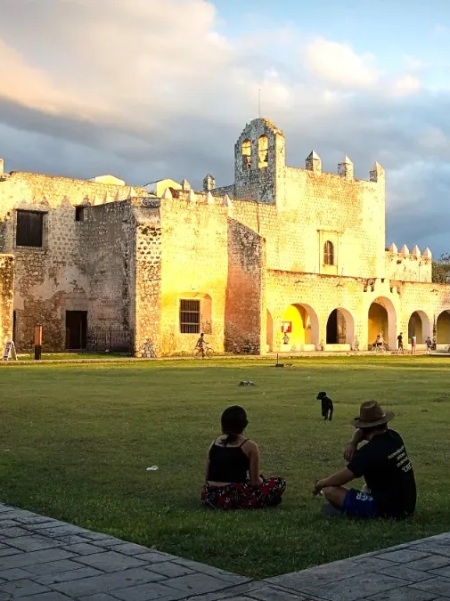
The San Bernardino Monastery in Valladolid, designed as a fortress; view from the atrium (2023, October).
The monastery of Valladolid
This impressive convent is one of the most beautiful buildings of the colonial Yucatán. It is called "Sisal" to the locals, but is better known as the Monastery of Saint Bernardino of Siena. Its construction was started in the year 1552, under the direction of the Franciscan Friar Juan de Mérida and Fathers Hernando de Guevara and Francisco de la Torre. It was erected over the vault of a very large cenote. The construction of the church ended in 1560, however the construction of the convent took longer. On both sides of the church’s altar there were two chapels, one for Saint Diego de Alcala and the second one for the Virgin of Guadalupe. One can still see some of the original paintings behind the altars pieces, as well as its ancient garden with its water wheel.

Valladolid, "Walk of the Friars" (Caminata de los Frailes), a new tourist project
The Franciscan friar Diego López de Cogolludo depicts the convent in his "Historia de Yucatán", first published in 1688:
The convent is located outside of town, among the Indians
"The convent of our Father Saint-Francis (managed by a guardian elected by the Chapters, from the year one thousand five hundred fifty-three) is located outside of town, at around six cuadras to the west. To go to the convent from town, one has to take a road of eight varas wide, made of stone and lime, with a parapet and bordered on both sides with trees called ceibas (yax che) which are very tall and thick and provide shade; in spite of being far, the convent is visited often by the inhabitants who are followers of our saintly religion. The church was built by masons and its nave is covered with a vault; it is dedicated to Saint-Bernardin of Sienna. While the altarpiece is painted on canvas, the tabernacle is a sculpture of modern design. On either side of the altar two chapels can be seen; one is dedicated to Our Lady of Guadalupe, fully sculpted with much inspiration and made in Guatemala; the other is dedicated to San Diego de Alcala with a painting on canvas. Around the church are three chapels: one dedicated to our Father Saint-Francis, the other one to Saint-Ann, and a third one protruding on the outside is for Saint-Anthony of Padua, built by the brothers of the Third Order of Penance, whose commissary is usually the preacher of the convent, who preaches sermons in the town parish. In the square in front of the church is the chapel of the Indians from the village of Zaqui, where the convent was founded; it is also dedicated to Saint-Bernardin of Sienna."
(Diego López de Cogolludo, Historía de Yucatán, book 4, chapter 16)

Valladolid, 2023, February, light show on the Franciscan monastery
It is built on a cenote (sinkhole)
"It is [the Yucatan] a humid and very fertile land, although very stony, and no river goes through it, but there are visible signs that abundant rivers run under the ground. In many places one discovers small or big natural openings in the rock that can be classified among other prodigious things; most often, they are twenty or twenty-four or more meters deep from the surface of the water, and as deep beneath the water. Underground, they are like big reservoirs with vaulted live rock, and it is impossible to know from where the water flows, and one can fish there, especially catfish. It is clear that they are subterranean rivers and the water is very light and tastes better than that of other wells dug out by men, and in some of these rivers, it was noticed that there was running water. Our convent of the town of Valladolid is partly built on one of these openings and the space occupied by the water underneath is rather vast, some say as big as two blocks of houses. Some people affirm that the fact that there are so many similar openings is the reason why there are so few earthquakes, whereas there are earthquakes in Guatemala and in New Spain and in the other kingdoms of the Indies. They are generally called Dzonót Cenote."
(Diego López de Cogolludo, Historía de Yucatán, book 4, chapter 1)
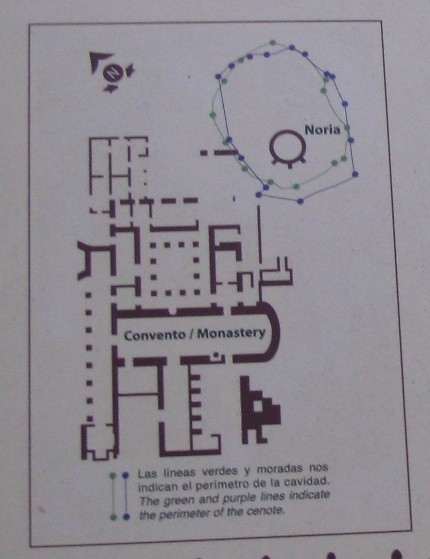
Map of the convent of Valladolid and its cenote (the green and purple lines indicate the perimeter of the cenote)
The Franciscan friars also ferreted out witches and sorcerers. The entire colony was familiar with everyday ‘magic’, the work of magicians. Such powers and practices elicited the interest and custom of Spaniards and mestizos. Cogolludo copies an account of Doctor V. Pedro Sánchez de Aguilar in his « informe contra los indios idólatras de esta tierra », about an event occured in Valladolid:
The devil speaks to the inhabitants of Valladolid
"It is neither improper to recall how my motherland, Valladolid, was persecuted and troubled in the years one thousand five hundred and sixty, according to my calculations, by a demon or a chatty spirit (a stunning and extraordinary case) that talked and chatted with all those willing to talk to him at eight or ten o’clock at night, in the dark, with all lights out : he chatted like a parrot and answered all the questions from a noble conquistador named Juan López de Mena, born in Logroño, and from another conquistador named Juan Ruiz de Arce from Las Montañas of Burgos. The spirit chatted and conversed more in their homes than in other places; he was asked to play hurdy-gurdy and he played it very well ; he played castanets when someone else played hurdy-gurdy. He was having fun and laughed, but never allowed anyone to see him." […]
Saint-Clement chases the devil out of town
"Our lord bishop was informed of the false testimonies he made and the insults he voiced against some people, and he forbade anyone to talk to him or answer to him, under the threat of a blame. And the inhabitants in effect stopped talking or responding to him after this excommunication; then the demon or the spirit started crying and complained about the bishop and multiplied the noises, the blows and the commotions on terraces and roofs, that scared people and deprived them of sleep. Afterwards, he began to set on fire the houses, most of which were built with straw and palms called guano; so much so that the inhabitants turned towards divine protection, met in church and asked the priest to ward off their ill fortune through the intervention of a saint; they promised to celebrate the day of that saint with a procession to the convent of Saint-Francis; the saint chosen was Saint-Clement, pope and martyr, whose day is November twenty-third; and today, while I copy this memoir to print it, with God’s grace, I accuse in His name my fellow countrymen who do not participate in this procession, leaving the priest alone, while the vote of the whole town and of their parents and grandparents had been unanimous. This saint is represented on the altarpiece of the church with a demon in chains."
(Diego López de Cogolludo, Historía de Yucatán, book 6, chapter 5, translated by Chantal Burns)
Valladolid, in the "Maya Train" station, March 2024
"The credulous historians of the sixteenth century and those who since have copied them took as indubitable the continuous and familiar commerce of the demon with all the idolatrous nations of the New World, and they hardly mentioned any event in which they did not present him as the principal actor. However, although it is certain that the malignity of those spirits is exerted when they can do evil to men and that sometimes they have presented themselves in visible form to seduce men, especially to those who have not yet entered into the bosom of the Church through their regeneration, it is not therefore credible that these representations were so frequent, nor [the demon's] commerce so free with those nations as is supposed by the historians; because God, who watches with loving providence over his creatures, does not permit those capital enemies of the human race so much liberty to harm."
Francisco Javier Clavijero, Historia antigua de México, Libro II. Viaje de los Mexicanos al país de Anáhuac. 1780
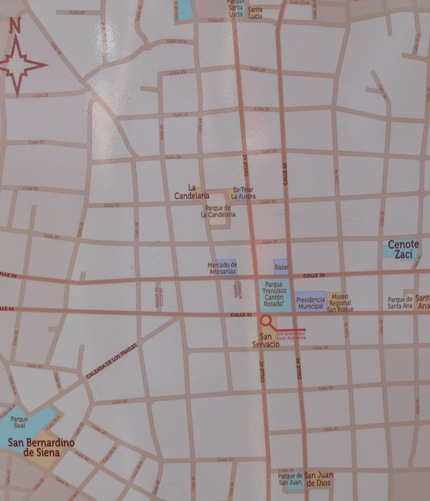
Map of the city of Valladolid : from rigth to left, the convent of Saint Bernard, the Friars causeway, the cenote Zaci
Antonio de Ciudad Real describes the city of Valladolid and its convent in 1588
"The Father Commissary stopped in Timozon [Temozon] about a half-hour and then, although before sunrise, he left there and travelling two and a half leagues, he arrived to say mass at the town and convent of Valladolid which by another name is called Zaqui or Zizal, where he was very well-received. There were many armadas, many people, music of trumpets and flutes, much pealing of bells, signs and demonstrations of joy at his arrival. The Indians came with their gifts of turkeys, chickens, iguanas, turtles, eggs, zapotes, bananas and other fruits, not only those people of that town but also from nearly the whole guardianía; all are Maya Indians and a pious people.
The town of Zaqui or Zizal is of medium size; there live in it, in a barrio for themselves, a few Mexican Indians, of those who came with the Spaniards during the Conquest.
The convent, dedicated to San Bernardino, is all finished with its church, cloister, dormitory and cells, built of stone and mortar and vaulted; it has next to the church a fine patio or yard and in it a ramada and chapel for the Indians. In that convent there is a fine garden, in which are raised bananas, alligator-pears, guavas, and all kinds of oranges, pitahayas, pineapples, grapes and a great deal of fine garden stuff. All is watered with water that comes from the noria of the town, which is almost next to the convent wall; and it is built on a very large Zonote, which is below ground, below the live rock itself, and has three or four mouths like the mouths of wells, one of which comes out at the convent kitchen, and on another is built the anoria of the town next to which are two large troughs (pilas), into which they draw water for the use of all. That zonote is very deep, and very wide and spacious and of very delicate water; many small but tasty bagres live in it; not far from it is another very large one, almost entirely open because it has a very wide mouth and they say it connects with that of the convent and that the water of both, as well as all the rest, passes through.
At an arquebus-shot from this convent is founded the town of Valladolid, a town of Spaniards, of eighty towns-people of which some have Indian towns in encomienda, others are merchants and traders and other officials, but all are poor. Nearly all the houses of that town are of stone and mortar and roofed with tiles, although some have flat roofs and others are covered with straw. Two parish priests (curas) live in the town and they have a fine church, also of stone and mortar and tiled; from the convent to the town there leads a road, closed on both sides with ceiba-trees, which are tall and thick and resemble the black poplar of Spain. Besides the Spaniards (there live) many Indians, their servants, (and) acquaintances and those of the Mexicans; in the convent four monks live. The Father Commissary visited them and remained till St. James’ Day, on which he preached to the Spaniards, many of whom came to hear him."
(Antonio de Ciudad Real, Tratado curioso y docto de las grandezas de la Nueva España, Vol II, Chap CXLIII)
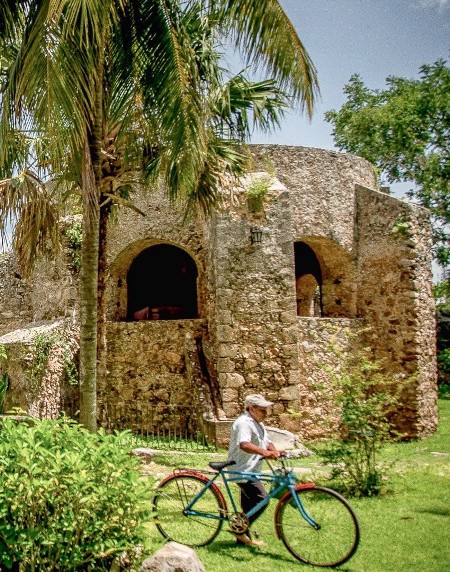
The garden of the Valladolid convent. The founders of the convent strived to create a self-sustaining community with sequestered vegetable gardens, an orchard and a noria for the water.
Valladolid in the Chronicle of Chicxulub:
"21. In the
year 1545 the Spaniards were posted at Valladolid, and in
this year Christianity began by the fathers of the order of San
Francisco in the port of Champoton; there first came the fathers
having in their hands the Redeemer Jesus Christ by name,
that they might teach the serving men; and first they came
to the port of Champutun to the west of this province
called here Ichcansiho, then to Merida, the town Ichcansiho
as it is called. These are the names of the fathers who began
Christianity in this country Yucatan, Fr. Juan de la Puerta, and
Fr. Luis de Villarpando, and Fr. Diego de Becal, and Fr.
Juan de Guerrero, and Fr. Merchol de Benavente, these
began Christianity in the west of this country, before
Christianity came here to Cupul; afterwards the trumpet of
Christianity came here, as I was saying, and it began here at
Cupul.
22. In the year 1546
there was a conjuration in the highlands of the
country; on the 9th of
November there had been peace for four months,
and it occurred on the 9th day of November of the year 1546 that
there was war after four months:
it began and continued for one year among the
men, when they were gathered together for the second time for the
tribute of wax; when the war began it
took place that the conjurors came
from the west to deceive the people and to set in order the war;
the conjuror Cunul and Ah Camal
came from the west and killed the Spaniards
and two sons of the Spaniards, scholars at Mena; they died at
Chamax, where they wished to
remain; then came to Valladolid all the Spaniards
who were well when the war broke out, and then began the
massacre; the conjuror Camal
Tipakan, of Pakam, killed Surusano over against Nicte; at
the towns one night the Spaniards were slain because the people
fell sick in their hands and
feet; there was then for a day and a night war
in all the towns.
23. In the year 1547 a
ship was destroyed by Ex Box at Ecab; then the
Spaniards went to make him fear, and made war against Box of Ecab,
son of Ek Box.
24. In the year 1548
the father Ermitanyo came to Valladolid to begin
Christianity.
25. In the year 1550
there was a general reunion of the towns and their
dependencies at Mani.
26. In the year 1551
the father guardian, Fr. Fernando Guerrero, came
from Valladolid to Sisal and he baptized the people and
introduced Christianity here
into all the territory of Valladolid west of the
Chels; they came from Ecab, they came from Cozumel, they came
from the north, they came from
the south, and also he began the building of the
monastery Valladolid-Sisal.
27. In the year 1552
the fathers settled here; in this year they came to
teach and sing here at Sisal, they came from the west to teach
and sing
mass vespers with the singing of the organ
and flute, and the canto llano, which never before did we know here."
(The Chronicle of Chac
Xulub Chen, by Nakuk Pech, 1562)
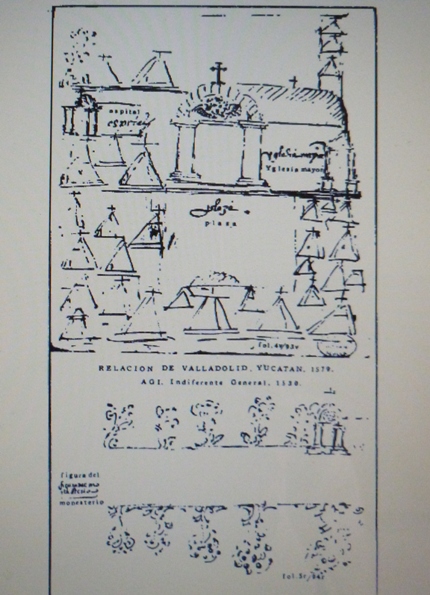
Blas Gonzalez, Alonso de Villanueva, Juan Gutierrez Picón, vecinos de Valladolid, Relación de la ciudad de Valladolid, Relaciones histórico-geográficas de Yucatán, 1579:
Above, the church, the square and the houses of the town; below, the road bordered with trees leading to the monastery
Antonio de Alcedo, 1786
"Valladolid, another city, in the province and government of Yucatan, founded by Francisco de Montejo, the younger, in 1543, in a place called Choaca ; and by the Indians, Chavachaa ; from whence it was, translated in the following year, from the unhealthiness of the spot, to where it now stands. It is small, and of a hot temperature ; has a very good parish church, an hospital with the name of Jesus Maria, and a convent of religious of St. Francis, which is a small distance without the city ; the rout to them being by a stone causeway, of about eight yards wide, and adorned on both sides by a beautiful poplar grove: — go miles w. of the Gulf of Honduras, 170 s. ao. of Truxillo, and 65 s. e. of Merida."
(Antonio de Alcedo, Diccionario geografico-histórico de las Indias Occidentales o América: es a saber: de los Reynos del Peru, Nueva España, Tierra Firme, Chile y Nuevo Reyno de Granada. Madrid, 1786/89)

Picture of the monastery by Désiré Charnay, 1886
The monastery of Valladolid in 1842
"In the barrio Sisal is the ruin of an old convent. Its crumbling walls tell of changes that are slowly developing themselves in the civilized world. It was an immense structure in its time, covering a space of two acres, enclosed within a high stone wall; and remains a painful monument of the mighty power which the order of Loyola [sic], its original proprietors, once exercised upon the destinies of this country. All that is now left is the church, and the house of the priest. The cloisters, corridors, and squares, are all fast going to pieces; and fragments of them are lying about in every direction. Its spacious halls are now the abode of the poor Indian, who aspires to a portion of the hallowed influence which is reputed to hang around its dilapidated walls. The crumbling turrets and blackened domes are covered with a wild vegetation, and have become a perch for the buzzard, and the hiding-place for loathsome reptiles. One of the wells connected with the monastery is dug through a solid rock to the depth of one hundred and fifty feet, when it opens upon a subterraneous river of pure water. In former times, a handsome temple was erected over it; the remains of a part of its dome still exist. There are not many pleasing associations connected with these places.”
(B.M. Norman, Rambles in Yucatan, including a visit to the remarkable ruins of Chi-Chen, Kahbah, Zayi, Uxmal, etc., 1843)

Valladolid, reconstitution of the revolution of 1910 against the president Porfirio Diaz (2023, April)
Valladolid
during the years of the Caste War
"Valladolid is a quiet city in the last stage of decay. It has been pretty. Once the streets were wide and well kept. They are yet wide, but overgrown with grass. Even the principal square is so choked with weeds that every now and then the indians are made to clear it. The roads have a small path in the middle, made and kept clean by the pedestrians, for the only carriages which pass at times are the carts that bring or take away goods – or a bolan coche arriving from or starting on a journey. Only one caleza exists there and it is never used. Entire streets are in ruins and no one dreams of rebuilding. They say the indians have destroyed them and they will do so again. They do not even clean and repaint the houses in the plaza mayor – such apathy, distrust, and fear of the indians. There are five churches – only two are in use and they are never filled. The church of Sisal with a ruined convent, is where the young ladies go to promenade, an easy kind of pilgrimage, for they do not retire without kneeling before the altars. The church in the square is in good condition, and in our estimation is prettier than the Cathedral of Merida."
(Alice Dixon Le Plongeon’s Diary, August 1875)
Alice Dixon (1851-1910) travelled to Yucatán with her husband the Maya archaeologist Augustus Le Plongeon. The
y were the first to excavate and systematically photograph the Maya sites of Chichén Itzá and Uxmal.

Tourism in Valladolid: Church of San Servasio, view from Hotel San Clemente
2025 "Friars and Mayas"
|


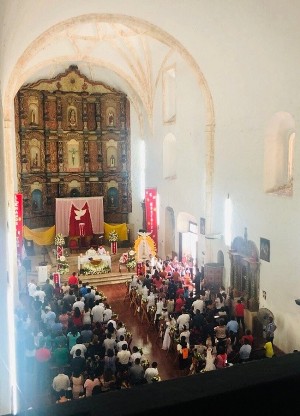
Convent of Valladolid, the high altar retable
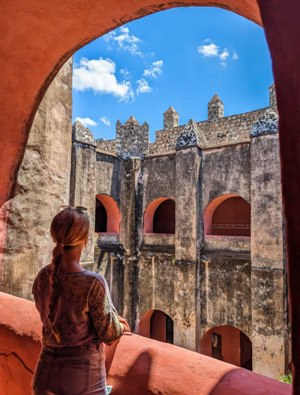
Convent of Valladolid. The cloister
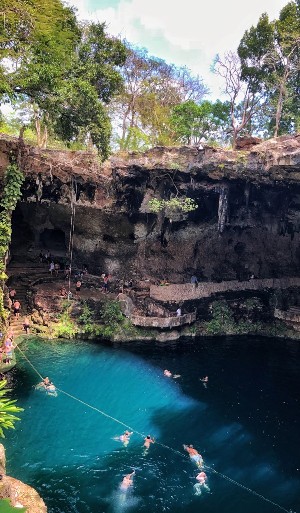
Valladolid, the Cenote Zaci. Located in the heart of Valladolid, this semi-open cenote is 45 meters in diameter and 80 meters deep. A third of the cenote is covered with stalactites and stalagmites, and there is a walkway around the entire cenote.
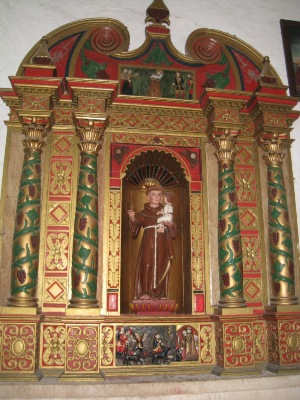
Convent of Valladolid. A retable. Saint Anthony of Padua
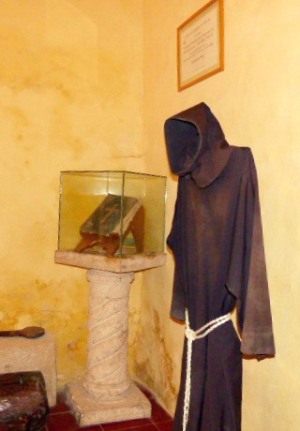
A Franciscan dress, in the convent

Valladolid, map of San Servacio church
